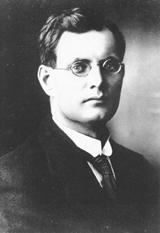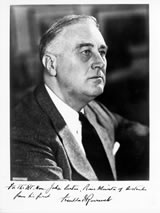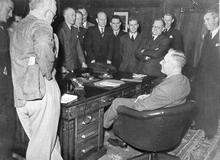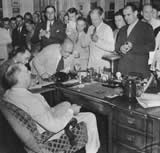
A central problem in exploring the Curtin-Roosevelt relationship is their lack of direct contact. Quite apart from fact that the two men only met on one brief occasion, they also seemed to inhabit such different social and political worlds. This was not just a product of the great distance that separated the two countries. It was also a matter of personality. Where Curtin was a committed socialist, a hardworking - and sometimes hard-drinking - union activist and newspaper editor, Roosevelt was an American aristocrat whose early political career slip-streamed in the wake of his illustrious cousin, Theodore Roosevelt, and whose elevation through state and national politics initially appeared to be so effortless. Moreover, where Curtin could be shy and somewhat dour, Roosevelt was outgoing and supremely self-assured - his image of the presidential office, writes one prominent political scientist, 'was himself-in-office.' 1
Yet both men were from the same generation, born in the first half of the 1880s. Both rose to the top of their professions, albeit enduring knocks, even tragedies, along the way: Curtin the travails of poverty as a teenager, and then the battles with alcohol in adulthood; Roosevelt the life-changing contraction of polio in 1921 which initially threatened to destroy his promising career but ultimately toughened his personality. 2 In addition, for all their pronounced personal and social differences, both men also moved in somewhat similar political universes. Thus while Curtin obviously made his career working with fellow union leaders and socialist politicians, Roosevelt, perhaps surprisingly, also got on well with reformers and labourites in the Curtin mould - and, indeed, his closest confidant was Harry Hopkins, a former social worker who'd risen to prominence in the rough and tumble of New York politics. 3
That Roosevelt had such friends reveals a second, more important, similarity. Broadly speaking, both were men of the left. Although the American concept of 'left' has rarely embraced the socialism that characterized Curtin's career, FDR's liberalism was sufficiently robust to encompass statist approaches to social issues. His New Deal, while not always internally consistent, revolved around a belief that the government could and should act to relieve the plight of Americans suffering immense hardships during the Great Depression. As well as his great economic and social programmes, including regional development, conservation projects, and social security, Roosevelt also became the global spokesman for democratic liberalism in the wake of the Axis challenge, calling on the world to implement the Four Freedoms - freedom of speech, freedom to worship, freedom from want, and freedom from fear.
The major difference in Roosevelt's and Curtin's political careers before 1941 was practical. In Australia, the Labor Party was in power in the early 1930s, when the Great Depression took hold, and its split over how to deal with the crisis helped to doom it to ten years in opposition. In the United States, the situation was quite different. It was the conservative Republican Party who presided over, and was held responsible for, the Depression. Roosevelt thus came to power in the wake of Republican failure. And though his New Deal never solved the economic crisis, his liberal dynamism was widely credited with alleviating the worst of its ills, with the result that Roosevelt soon became electorally unassailable.
During the 1930s, then, the contrast in the two men's careers could not have been more pronounced. While Curtin, who became Labor Party leader in 1935, languished in opposition until October 1941, FDR won an unprecedented three presidential elections in 1932, 1936, and 1940 (and would win a fourth in 1944). Political success on this scale, quite apart from Roosevelt's public panache, was naturally noted by moderate left-wing politicians throughout the world. And Curtin was no exception. Initially, he welcomed the New Deal, albeit with doubts that FDR could make headway against the vested capitalist interests inside the United States. As Prime Minister, he then laced his speeches with warm references to Roosevelt's great public manifesto, the Four Freedoms, calling repeatedly for a post-war world that would end want and deprivation. In short, for all their personal differences, the two men were very much on the same side of the political divide. 4
In foreign affairs, too, they shared similar ideas, which were common to many on the left of the political spectrum. After the carnage of 1914-1918, both men were vocal in their opposition to war, believing that it merely resulted in mechanized slaughter for no clear gain. But neither were pacifists. Far from it: they both endorsed the use of violence for national self-defence. And as the international crisis deepened during the late 1930s, they also envisaged a leading role for their nations' air forces, conceiving air power as perhaps the best method of protecting their countries that, hitherto, had been geographically remote from main threats in Europe and Asia. 5
In 1941, both men became war leaders. For Roosevelt, this was part of a gradual process of reorientating his presidency away from internal reform as the international crisis deepened in the late 1930s. In Curtin's case, he suddenly became Prime Minister in October, a relative novice in the day-to-day running of government. Yet both men had to handle somewhat similar leadership tasks. Both were in power at a time when state bureaucracies were growing rapidly, and so confronted the problem of trying to maintain a measure of control over the sprawling new bureaucracies. Roosevelt's solution was to ignore formal hierarchy. As Arthur Schlesinger Jr argued, to ensure that control of all decisions remained in his hands, he 'deliberately organized - or disorganized - his system of command', often giving similar tasks to a bewildering array of different advisers, from Wilsonian internationalists to those with a 'Europhobic-cum-hemispheric tendency'. 6 Although never an advocate of such a chaotic system, Curtin did skilfully manage a fractious Cabinet of clashing egos. When colleagues were away or not quite up to the job, he was perfectly ready to fill in for them. And he was not always a rigid respecter of bureaucratic domains, turning often to Ben Chifley, his number two, for advice, and, when it came to his one taste of overseas diplomacy, firmly freezing the External Affairs Ministry out of direct participation. 7
As well as trying to control and direct the state apparatus, both men also had to sustain their nation's morale through the long and bloody war. Both recognized the power of the media, and were confident they could use it as a tool to reach the wider public audience. In fact, both prided themselves on their journalistic experience and expertise, although in Curtin's case this was far more extensive. Indeed, while Curtin had notched up years as an editor in Perth, Roosevelt had merely enjoyed a few months working for a Harvard student paper. But such a brief apprenticeship never stopped the supremely self-confident President from lecturing reporters on how best to write up their stories. And, like the Prime Minister, he was always keen to invite the press corps into his office. The cosy atmosphere that prevailed in such gatherings - and which is recaptured in the accompanying photos - was by no means illusory. Both leaders could generally rely on the press to withhold important secrets. Curtin, in particular, developed a remarkably close relationship with leading reporters, even informing them of matters of utmost secrecy, safe in the knowledge that reporters would thereby have a better understanding of the problems thrown up by the war, but would never dream of publishing any sensitive information in their newspapers. 8 Roosevelt, although facing the hyper-competitive world of the American journalism, was generally able to forge a similar partnership with the journalists, not least because, like Curtin, he made sure that they were 'welcomed as gentlemen, not suspected as spies.' 9
 John Curtin aged 34, 1919.
John Curtin aged 34, 1919.
Records of the Curtin Family. JCPML00004/5.
 Franklin D Roosevelt. Inscribed "For The Rt Hon John Curtin, Prime Minister of Australia From his friend Franklin D Roosevelt", n.d. JCPML00376/123.
Franklin D Roosevelt. Inscribed "For The Rt Hon John Curtin, Prime Minister of Australia From his friend Franklin D Roosevelt", n.d. JCPML00376/123.
![Labor Day procession ["Make Jack Curtin Prime Minister" banner], 1937. JCPML00568/10/2.](pics/JCPML00568_10_2s.jpg) Labor Day procession ["Make Jack Curtin Prime Minister" banner], 1937. Records of Bobbie Oliver. JCPML00568/10/2.
Labor Day procession ["Make Jack Curtin Prime Minister" banner], 1937. Records of Bobbie Oliver. JCPML00568/10/2.

Former journalist John Curtin meets the Canberra Press Gallery. (Known as The Circus) C.1945. Records of the Curtin Family. JCPML00376/2.

Roosevelt meets with the media at a presidential press conference, 1939.
Image from: Casey, S. 2001,
Cautious Crusade: Franklin D. Roosevelt, American public opinion,
and the war against Nazi Germany,
Oxford University Press,
London, p. 32.